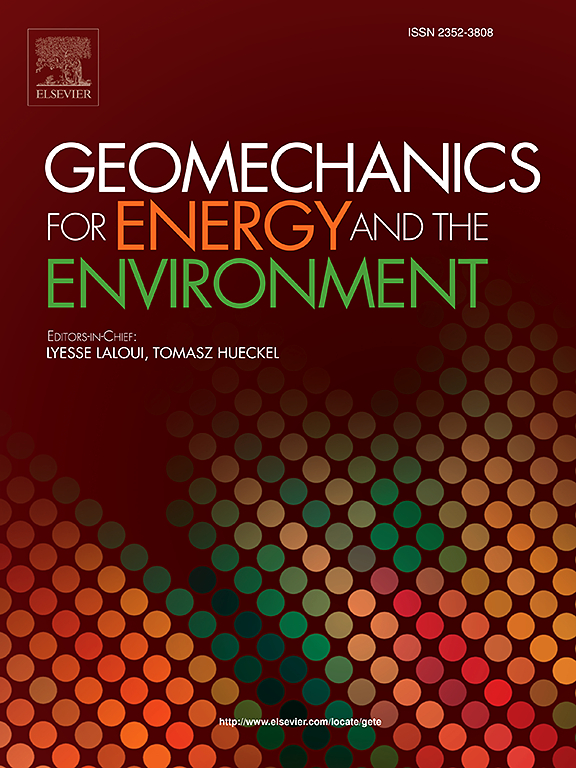水射流辅助采煤SPH-FEM耦合建模:数值模拟与实验验证
IF 3.7
2区 工程技术
Q3 ENERGY & FUELS
引用次数: 0
摘要
煤炭仍然是全球能源供应的基石,推动了对更高效、技术更先进的开采方法的需求。本文介绍了一种数值框架,将光滑颗粒流体动力学(SPH)与有限元法(FEM)相结合,来模拟煤在水射流辅助切割下的动态响应。水射流辅助切割是一种新兴的技术,因其适用性、应力扰动最小和在地下开采中安全的工作条件而得到认可。该模型在LS-DYNA中实现,可捕获两相流固相互作用,包括射流诱导的裂缝萌生、扩展和材料去除。详细的参数研究评估了射流速度、喷嘴直径、撞击角和切割时间对煤破碎行为的影响。模型预测通过受控的实验室实验得到了严格验证,与经验结果实现了可靠的相关性——切割深度(CD)的平均绝对误差为7.2 %,切割体积(CV)的平均绝对误差为5.8 %。为了解决纯水射流(PWJ)系统的性能限制,对磨料水射流(AWJ)和冰磨料水射流(IAWJ)技术进行了扩展模拟。AWJ配置使CD和CV分别提高了51 %和66 %,而IAWJ比PWJ提高了20 %。应力场分析进一步表明,增大射流速度比增大喷嘴更能有效地提高切削效率。这些发现不仅验证了SPH-FEM模型作为预测工具的有效性,而且为优化深煤开采应用中的下一代水射流系统提供了可行的见解。本文章由计算机程序翻译,如有差异,请以英文原文为准。
Coupled SPH–FEM modeling of waterjet-assisted coal cutting: Numerical simulation and experimental validation
Coal remains a cornerstone of global energy supply, driving the need for more efficient and technologically advanced extraction methods. This study introduces a numerical framework that couples the Smoothed Particle Hydrodynamics (SPH) with the Finite Element Method (FEM) to model the dynamic response of coal under waterjet-assisted cutting—an emerging technique recognized for its applicability, minimal stress disturbance, and safe working conditions in underground mining. Implemented in LS-DYNA, the model captures two-phase fluid–solid interactions, including jet-induced fracture initiation, propagation, and material removal. A detailed parametric investigation evaluates the effects of jet velocity, nozzle diameter, impingement angle, and cutting duration on coal fragmentation behavior. Model predictions were rigorously validated through controlled laboratory experiments, achieving reliable correlation with empirical results—showing mean absolute errors of 7.2 % in Cutting Depth (CD) and 5.8 % in Cutting Volume (CV). To address the performance constraints of Pure Water Jet (PWJ) systems, extended simulations were conducted for Abrasive Water Jet (AWJ) and Ice Abrasive Water Jet (IAWJ) techniques. The AWJ configuration enhanced CD and CV by 51 % and 66 %, respectively, while IAWJ achieved up to 20 % improvement over PWJ. Stress field analysis further revealed that increased jet velocity is significantly more effective than nozzle enlargement in maximizing cutting efficiency. These findings not only validate the SPH–FEM model as a predictive tool but also offer actionable insights for optimizing next-generation waterjet systems in deep coal mining applications.
求助全文
通过发布文献求助,成功后即可免费获取论文全文。
去求助
来源期刊

Geomechanics for Energy and the Environment
Earth and Planetary Sciences-Geotechnical Engineering and Engineering Geology
CiteScore
5.90
自引率
11.80%
发文量
87
期刊介绍:
The aim of the Journal is to publish research results of the highest quality and of lasting importance on the subject of geomechanics, with the focus on applications to geological energy production and storage, and the interaction of soils and rocks with the natural and engineered environment. Special attention is given to concepts and developments of new energy geotechnologies that comprise intrinsic mechanisms protecting the environment against a potential engineering induced damage, hence warranting sustainable usage of energy resources.
The scope of the journal is broad, including fundamental concepts in geomechanics and mechanics of porous media, the experiments and analysis of novel phenomena and applications. Of special interest are issues resulting from coupling of particular physics, chemistry and biology of external forcings, as well as of pore fluid/gas and minerals to the solid mechanics of the medium skeleton and pore fluid mechanics. The multi-scale and inter-scale interactions between the phenomena and the behavior representations are also of particular interest. Contributions to general theoretical approach to these issues, but of potential reference to geomechanics in its context of energy and the environment are also most welcome.
 求助内容:
求助内容: 应助结果提醒方式:
应助结果提醒方式:


